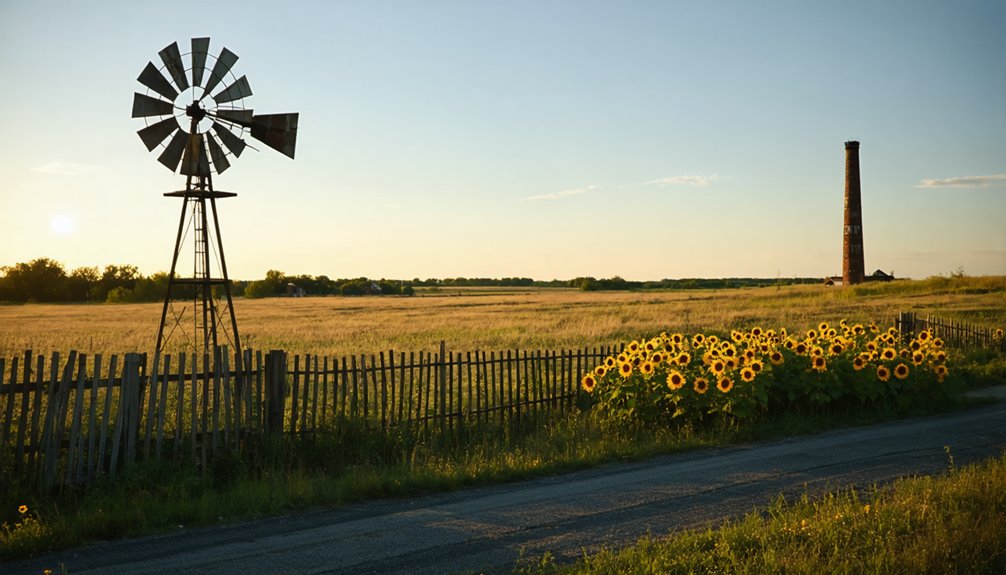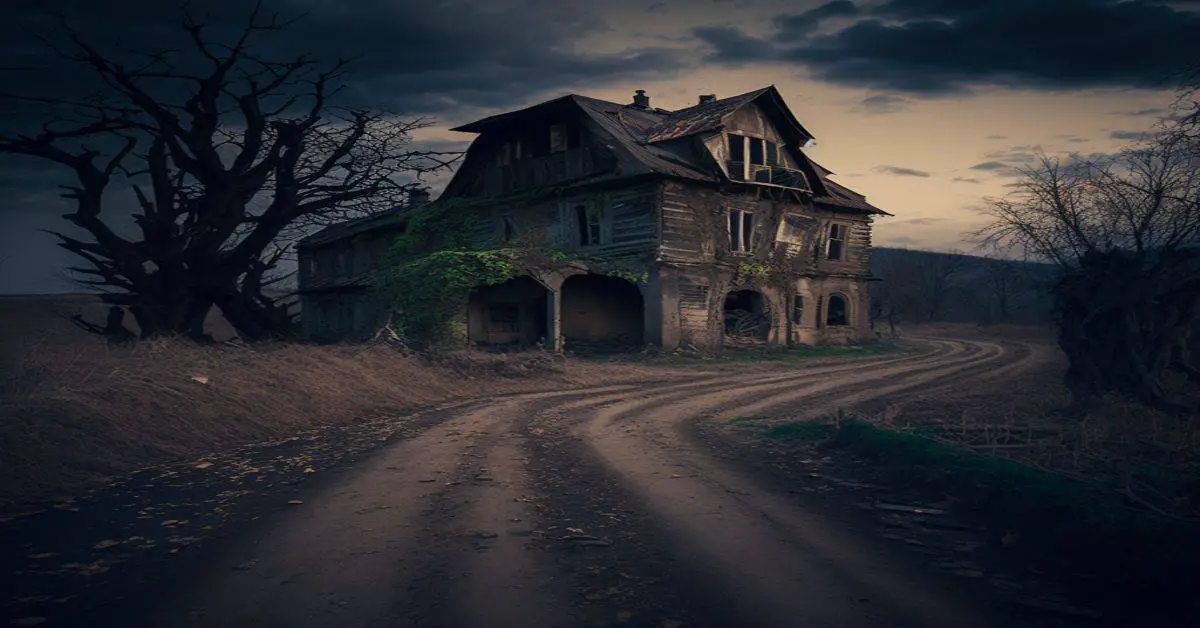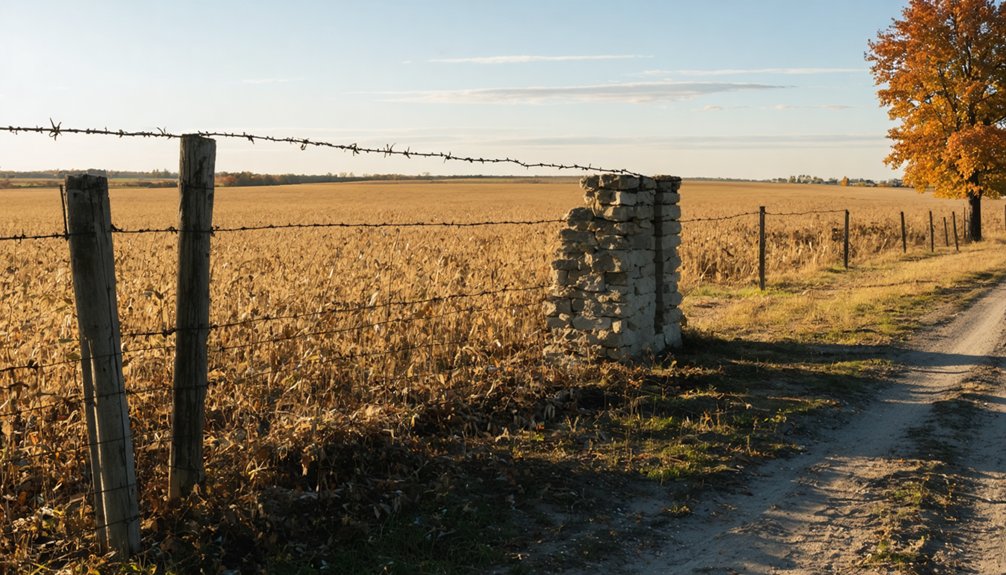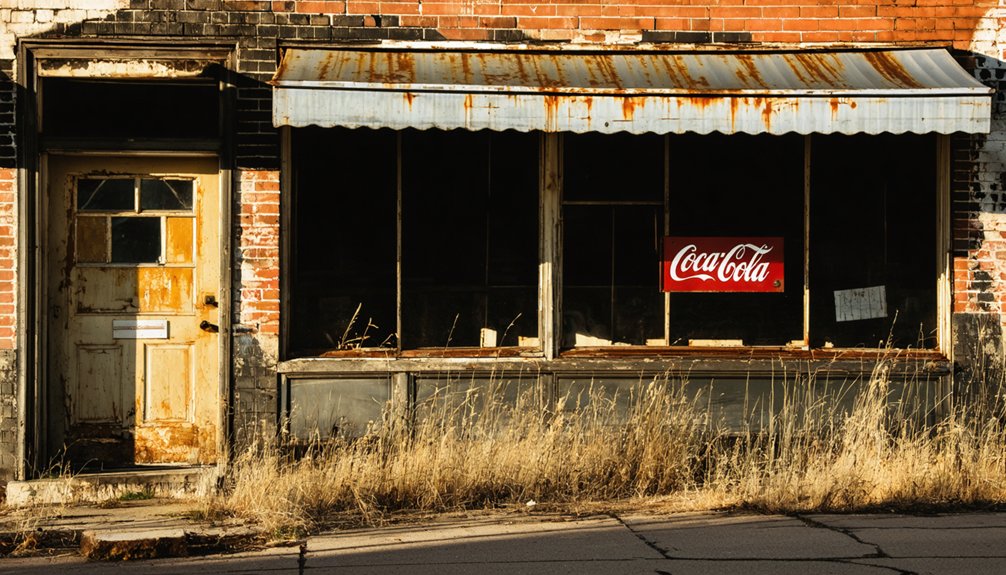You’ll find Kumler’s ghost town site about five miles northeast of Farmer City in McLean County, Illinois. This former farming settlement, named after Bishop Henry Kumler Sr., thrived in the 1800s but gradually faded like many Midwestern agricultural communities. Today, only open fields along State Highway 54 mark where this prairie town once stood. While no structures remain, Kumler’s story lives on through local tales of pioneering families and bustling harvest seasons.
Key Takeaways
- Kumler, Illinois was a farming settlement located 5 miles northeast of Farmer City in McLean County at coordinates 40°17′59″N, 88°34′41″W.
- Named after Bishop Henry Kumler Sr., the town emerged in the early 1800s as a prairie farming community after the War of 1812.
- The town’s decline was gradual, caused by lack of rail connections, agricultural mechanization, and economic competition from nearby Farmer City.
- No buildings or structures remain at the site today, with the area completely reclaimed by agricultural fields along State Highway 54.
- McLean County Historical Society preserves Kumler’s history through records and documentation of its agricultural significance in Illinois.
Geographic Location and Features
Located in West Township of McLean County, Illinois, Kumler sits approximately five miles northeast of Farmer City at an elevation of 735 feet above sea level.
You’ll find this ghost town at precise coordinates of 40°17′59″N and 88°34′41″W, along State Highway 54 in the heart of America’s prairie landscape.
The geographic significance of Kumler stems from its position in the fertile Illinois prairie, where the terrain gradually slopes across the Midwestern plain.
Nestled in fertile Illinois prairie lands, Kumler marks where gentle slopes roll endlessly across the Midwest’s vast agricultural expanse.
The environmental characteristics you’ll encounter reflect typical rural Illinois features – expansive agricultural fields stretching toward the horizon.
Like the former Rike Kumler Co. in Dayton, Ohio, this settlement has become a historical remnant of America’s past.
The area shares its name with prominent religious figure Henry Kumler Sr., who served as a bishop in the Church of the United Brethren in Christ.
While no notable landmarks remain in this abandoned settlement, you’re surrounded by the raw beauty of Illinois farmland.
The site’s accessibility via major roadways makes it an interesting stop for those exploring America’s forgotten places.
Early Settlement and Origins
The story of Kumler begins in the early 1800s, when pioneers pushed westward into Illinois following the War of 1812.
You’ll find that like many frontier settlements of the time, Kumler emerged from the dreams of hardy settlers seeking to build new lives on the prairie.
Canal systems played a vital role in connecting Kumler to broader commercial networks, enabling trade and growth.
While the exact founders aren’t well documented, they faced typical pioneer challenges – breaking virgin soil, establishing homesteads, and creating a community from scratch.
The settlement patterns followed a familiar script: farming families staked their claims, hoping to capitalize on McLean County’s rich agricultural potential.
You’d have found a small but determined mix of European-American pioneers, craftsmen, and laborers working to establish roots.
Though Kumler never grew into a major town, it represented the bold spirit of frontier expansion that defined Illinois’ early development.
Today, this disambiguation page link helps researchers and historians locate accurate information about the ghost town’s past.
Life in Historic Kumler
Despite its modest size, life in historic Kumler reflected the quintessential rhythms of a 19th-century Illinois farming community.
You’d find families working their fields from sunup to sundown, tending to crops and livestock that sustained their livelihood. Their wood-frame homes and simple farmsteads dotted the rural landscape, connected by dirt roads that carried horse-drawn wagons to and from market.
Community gatherings centered around the local church and schoolhouse, where farming practices were discussed alongside Sunday sermons and children’s lessons. Much like in Buda, where everybody knows everybody, these tight-knit relationships defined daily life in the settlement. Located in West Township, McLean County, Kumler represented a typical rural settlement of its era.
You’d witness neighbors helping neighbors during harvest time, sharing equipment and labor to bring in the season’s yield.
While specific records of Kumler’s institutions are scarce, the town’s social fabric was woven through these daily interactions and shared agricultural traditions.
Transportation and Infrastructure
While railroads proved essential to the survival of many Illinois settlements in the 1800s, Kumler’s lack of direct rail connections ultimately contributed to its downfall.
Similar to the Northern Cross railroad that first connected Springfield to Meredosia in 1842, reliable rail service was crucial for town survival during this era.
You’ll find evidence of this transportation evolution in the remnants of gravel roads that once connected to State Highway 54, now serving as silent witnesses to the town’s past.
Infrastructure challenges plagued Kumler throughout its existence. Without a railroad depot or roundhouse, the town struggled to maintain economic relevance as transportation patterns shifted. Like many lost townships, Kumler’s population dwindled below 1,000 residents.
You can still trace where roads once bustled with activity, though they’re now mostly forgotten paths. When automobiles became the dominant mode of transport and new highways redirected traffic elsewhere, Kumler couldn’t adapt.
The town’s isolation from major transportation arteries sealed its fate, leading to its eventual abandonment.
Economic Activities and Commerce
In Kumler’s heyday, you’d find the local economy centered around agricultural trade, with farmers bringing their grain, livestock, and produce to sell or ship via the railroad.
You could see wagons lined up at the grain elevator during harvest season, as the railroad made Kumler an important shipping point for McLean County’s abundant farm products.
The town’s strategic position along the rail line allowed local merchants to receive wholesale goods and enabled farmers to efficiently transport their harvests to larger markets in Bloomington and beyond.
Like the valuable salt deposits that drove early commerce in Old Shawnee Town, Kumler’s agricultural resources were essential to its economic success.
Agricultural Trade Patterns
Through its network of local trade hubs like Weston and Carlock, Kumler’s agricultural commerce flourished during its peak years. You’d find farmers hauling their corn, soybeans, wheat, and oats to these bustling centers, where trading practices evolved to meet the growing demands of regional markets.
The seasonal rhythm of planting and harvesting dictated the crop exchanges, with farmers timing their sales for maximum profit. Early settlers initially overlooked the region’s vast prairies, believing they would remain unsettled wasteland.
What’s remarkable about Kumler’s trade patterns was how the drainage of swampy prairies transformed the region’s agricultural potential. You could’ve watched as farmers turned previously unusable land into productive fields, dramatically increasing their trading power.
They’d coordinate with neighboring counties and states, establishing essential commerce routes that helped build the region’s economic strength.
Railroad Shipping Hub
The bustling railroads transformed Kumler into a dynamic shipping hub, building upon its agricultural foundation. You’d find the Illinois Terminal System‘s electrified lines connecting your goods to major markets like St. Louis and Peoria, while the Illinois Central’s extensive network opened up even more freight routes.
Railroad expansion brought warehouses and transfer points, making Kumler a crucial link in the region’s commerce. If you’d operated a business here, you’d have benefited from the dense rail network that moved everything from grain to coal.
The McKinley Bridge‘s construction in 1910 gave you direct access to St. Louis markets, while the surrounding terminal and switching lines meant your shipments could reach industrial centers efficiently. Kumler’s position along these critical freight corridors made it an indispensable stop in central Illinois’ commercial landscape.
The Path to Abandonment
While many ghost towns trace their demise to sudden catastrophes or industrial collapse, Kumler’s path to abandonment followed a quieter, more gradual decline typical of Midwestern farming communities.
You’ll find no dramatic events marking its disappearance – no floods, mine closures, or rerouted railroads sealed its fate. Instead, the abandonment causes stemmed from broader agricultural shifts that transformed America’s heartland.
As farms grew larger and more mechanized, fewer workers were needed, triggering demographic shifts away from tiny settlements like Kumler. The town’s proximity to Farmer City pulled away what remaining commerce existed, while its lack of diversification beyond agriculture left it vulnerable.
Present-Day Remnants
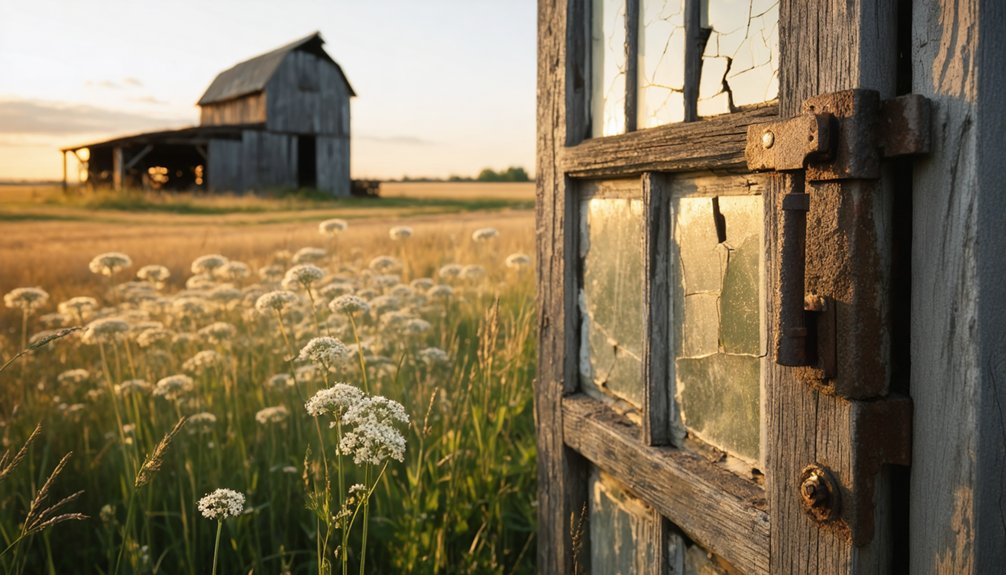
Standing along State Highway 54 in McLean County, today’s Kumler offers little evidence of its former existence as a rural settlement.
You’ll find yourself surrounded by vast Illinois farmland at an elevation of 735 feet, with no remaining structures to hint at the community that once stood here. The present-day landscape has been completely reclaimed by agriculture, and unlike other ghost town remnants in Illinois, you won’t spot any crumbling foundations or abandoned buildings to explore.
While the town’s name and coordinates still appear on some digital maps, visiting the site at 40°17′59″N 88°34′41″W reveals only open fields.
If you’re hoping to discover physical traces of Kumler’s past, you’ll need to rely on historical records rather than visible remains.
Local Tales and Legends
Unlike many historic ghost towns that inspire colorful local legends, Kumler’s folklore remains particularly silent.
While you’ll find rich tales of ghostly sightings throughout Illinois, this McLean County settlement hasn’t generated the supernatural stories you might expect. The town’s quiet abandonment seems to mirror its lack of folklore origins, setting it apart from other Illinois ghost towns with their vibrant mythologies.
- No documented supernatural encounters, unlike nearby communities
- Absence of Native American legends specific to the location
- Missing from the region’s collection of monster tales and creature sightings
- Lacks the dramatic abandonment stories common to other ghost towns
While Illinois boasts famous legends like the Piaza bird and Tuttlebottoms Monster, Kumler’s story is one of simple economic decline, where reality proves more straightforward than myth.
Legacy in McLean County
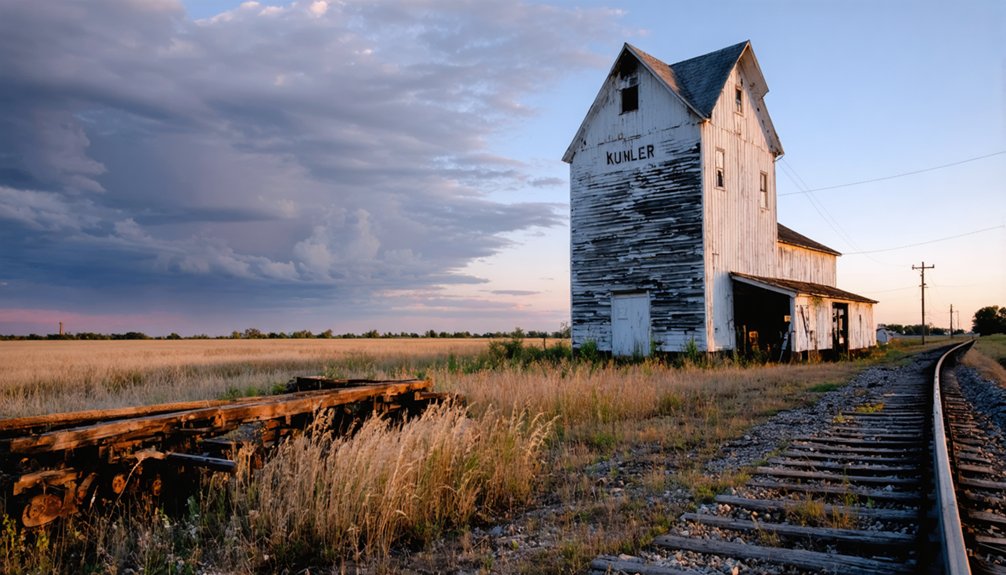
You’ll still find Kumler’s agricultural footprint in McLean County’s rich farmland, where modern farming operations continue on the same fertile soil that once sustained the town’s earliest settlers.
While the original buildings have vanished, today’s farmers work the surrounding fields using GPS-guided equipment where horse-drawn plows once broke the prairie soil.
The McLean County Historical Society preserves Kumler’s memory through photographs, documents, and oral histories that tell the story of this vanished prairie community.
Historical Agricultural Significance
As McLean County transformed from frontier wilderness to agricultural powerhouse in the 19th century, Kumler emerged as an essential farming community that helped shape the region’s agricultural legacy.
You’ll find that the area’s rich prairie soil and strategic location near Buckles Grove made it perfect for pioneering agricultural practices and crop diversity. Local farmers didn’t just survive – they thrived by adapting innovative methods and embracing new technologies.
- John C. Thomas’s 5,000-bushel corn crib showcased the area’s impressive grain storage capabilities
- The arrival of railroads connected Kumler’s farmers to lucrative distant markets
- Local stockyards facilitated the movement of thousands of hogs and cattle
- 4-H programs fostered agricultural knowledge among the region’s youth, ensuring farming traditions continued
The community’s agricultural heritage lives on in McLean County’s enduring farming success.
Modern Land Usage
Though Kumler’s vibrant farming community has long since faded into history, its lands continue to serve McLean County’s agricultural heritage. You’ll find the former town site nestled in West Township, where private land ownership and county zoning regulations now govern the area’s use.
The once-bustling streets have given way to vast stretches of corn and soybean fields, seamlessly blending into McLean County’s productive agricultural landscape.
If you venture out to Kumler today, you won’t find any public facilities or active infrastructure – just fertile farmland and perhaps a few remnant trails used by farm machinery.
While nearby towns like Bellflower and Farmer City thrive with modern amenities, Kumler’s legacy lives on primarily through the soil that still yields bountiful harvests each season.
Community Memory Preservation
Despite Kumler’s physical absence from the modern landscape, its legacy endures through McLean County’s robust preservation efforts.
You’ll find the story of this vanished town carefully woven into the fabric of local memory preservation initiatives, where community storytelling takes center stage at the McLean County Museum of History.
- The museum’s speaker bureau shares Kumler’s story through engaging presentations that keep the town’s memory alive
- Digital archives make Kumler’s history accessible to researchers and curious locals alike
- Educational programs connect students with the ghost town’s past through interactive exhibits
- Community events and walking tours incorporate Kumler’s narrative into the broader McLean County story
Through these preservation efforts, you’re invited to explore how Kumler, though gone, remains an important chapter in McLean County’s cultural heritage.
Frequently Asked Questions
Were Any Notable Crimes or Mysterious Events Reported in Kumler?
You won’t find unsolved mysteries or ghost sightings in this quiet railroad settlement’s past. Historical records show no notable crimes or unexplained events among the weathered buildings and empty fields.
Did Any Famous People or Historical Figures Visit Kumler?
You won’t find records of any famous visitors or historical figures stopping in Kumler. The town’s limited size and brief existence didn’t attract notable personalities before it faded into obscurity.
What Was the Highest Recorded Population of Kumler?
Like a fading whisper in time, Kumler’s history doesn’t reveal its peak population in official records. You won’t find exact numbers, but population trends suggest it never exceeded 200 residents as a hamlet.
Were There Any Schools or Churches Operating in Kumler?
You won’t find any records of schools or churches operating in Kumler. The small community’s residents likely traveled to nearby Farmer City for their education and religious gatherings.
Did Native American Tribes Inhabit the Area Before Kumler’s Establishment?
Thousands of Native tribes, including the mighty Illinois Confederation, called your region home. You’ll find their cultural heritage in tribes like the Kaskaskia, Peoria, and Kickapoo who lived there before removal.
References
- https://www.wikiwand.com/en/articles/Kumler
- https://en.wikipedia.org/wiki/Kumler
- https://www.youtube.com/watch?v=gM3ZIgtFzBk
- https://drloihjournal.blogspot.com/p/lost-towns-of-illinois-series.html
- https://www.youtube.com/watch?v=fy3yJDBA5nI
- https://sangamoncountyhistory.org/wp/14696/
- https://drloihjournal.blogspot.com/2022/09/lost-towns-of-illinois-kumler-illinois.html
- https://storymaps.arcgis.com/stories/043201d4267e4a66b44e7922832df7a2
- https://en.wikipedia.org/wiki/List_of_ghost_towns_in_Illinois
- https://brainly.infogalactic.com/info/Kumler
